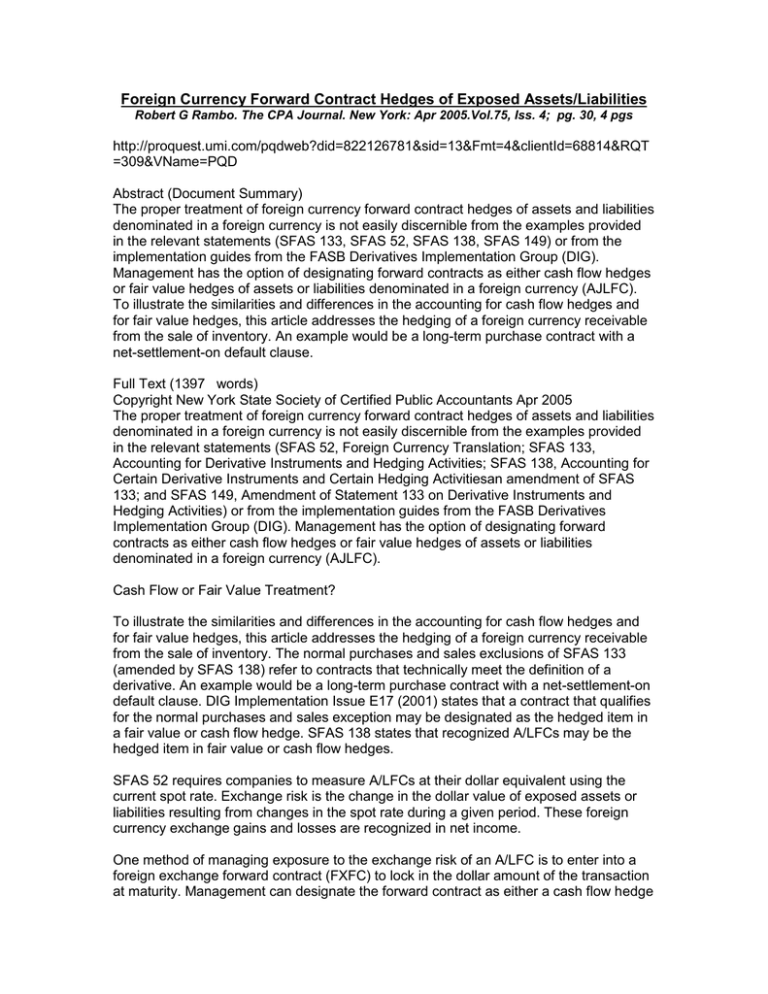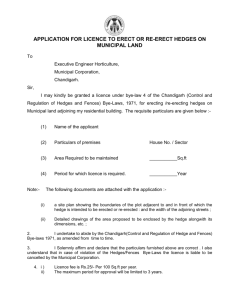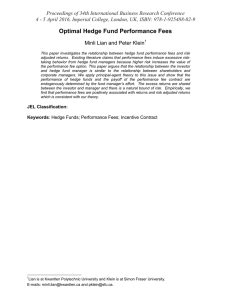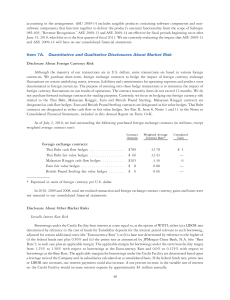Foreign Currency Forward Contract Hedges of Exposed Assets/Liabilities
advertisement

Foreign Currency Forward Contract Hedges of Exposed Assets/Liabilities Robert G Rambo. The CPA Journal. New York: Apr 2005.Vol.75, Iss. 4; pg. 30, 4 pgs http://proquest.umi.com/pqdweb?did=822126781&sid=13&Fmt=4&clientId=68814&RQT =309&VName=PQD Abstract (Document Summary) The proper treatment of foreign currency forward contract hedges of assets and liabilities denominated in a foreign currency is not easily discernible from the examples provided in the relevant statements (SFAS 133, SFAS 52, SFAS 138, SFAS 149) or from the implementation guides from the FASB Derivatives Implementation Group (DIG). Management has the option of designating forward contracts as either cash flow hedges or fair value hedges of assets or liabilities denominated in a foreign currency (AJLFC). To illustrate the similarities and differences in the accounting for cash flow hedges and for fair value hedges, this article addresses the hedging of a foreign currency receivable from the sale of inventory. An example would be a long-term purchase contract with a net-settlement-on default clause. Full Text (1397 words) Copyright New York State Society of Certified Public Accountants Apr 2005 The proper treatment of foreign currency forward contract hedges of assets and liabilities denominated in a foreign currency is not easily discernible from the examples provided in the relevant statements (SFAS 52, Foreign Currency Translation; SFAS 133, Accounting for Derivative Instruments and Hedging Activities; SFAS 138, Accounting for Certain Derivative Instruments and Certain Hedging Activitiesan amendment of SFAS 133; and SFAS 149, Amendment of Statement 133 on Derivative Instruments and Hedging Activities) or from the implementation guides from the FASB Derivatives Implementation Group (DIG). Management has the option of designating forward contracts as either cash flow hedges or fair value hedges of assets or liabilities denominated in a foreign currency (AJLFC). Cash Flow or Fair Value Treatment? To illustrate the similarities and differences in the accounting for cash flow hedges and for fair value hedges, this article addresses the hedging of a foreign currency receivable from the sale of inventory. The normal purchases and sales exclusions of SFAS 133 (amended by SFAS 138) refer to contracts that technically meet the definition of a derivative. An example would be a long-term purchase contract with a net-settlement-on default clause. DIG Implementation Issue E17 (2001) states that a contract that qualifies for the normal purchases and sales exception may be designated as the hedged item in a fair value or cash flow hedge. SFAS 138 states that recognized A/LFCs may be the hedged item in fair value or cash flow hedges. SFAS 52 requires companies to measure A/LFCs at their dollar equivalent using the current spot rate. Exchange risk is the change in the dollar value of exposed assets or liabilities resulting from changes in the spot rate during a given period. These foreign currency exchange gains and losses are recognized in net income. One method of managing exposure to the exchange risk of an A/LFC is to enter into a foreign exchange forward contract (FXFC) to lock in the dollar amount of the transaction at maturity. Management can designate the forward contract as either a cash flow hedge or a fair value hedge of the exposed A/LFC, because changes in spot rates affect both the fair value and the cash flows of foreign currency receivables or payables. The total gain or loss on the FXFC can be segregated into two components. The first corresponds to the change in fair value of the FXFC resulting from changes in the spot rate, and offsets the gain or loss on the underlying A/LFC. The second component represents the initial premium or discount on the forward contract. Thus, the net gain or loss will be the initial premium or discount. The accounting for the two components is based on whether the FXFC is a cash flow hedge or a fair value hedge. EXHIBIT 1 Spot Rates, Forward Rates, Valuations, Gains and Losses, and Discount Amortizations over Contract Period Accounting for cash flow hedges of A/LFC under SFAS 138 is different from the usual accounting for cash flow hedges. Mark A. Trombley, in Accounting for Derivatives and Hedging (McGrawHill/Irwin, 2003), summarizes the procedure as follows: * Hedge effectiveness is assessed by comparing the change in the value of the derivative attributable to changes in spot rates, excluding any changes in forward discount or premium, with the change in the value of the hedged item. Because A/LFCs are also measured using spot rates, this satisfies the highly effective hedge criteria. * The hedged A/LFC is adjusted to fair value based on current spot rates, and a gain or loss due to a change in fair value is recognized in earnings. * The entire change in the fair value of the derivative (both the spot rate change and the change in forward discount or premium) is reported in other comprehensive income (OCI). This differs from the normal accounting for cash flow hedges in that the change in the forward discount or premium, which is excluded in determining hedge effectiveness, is not recognized in earnings. * An amount equal to the gain or loss on the hedged item is then reclassed from CXZI and recognized in earnings. * The allocation of the original forward discount or premium is amortized using an effective rate method, and reclassed from OCI to earnings. Changes in the total value of fair value hedges are recognized as gains and losses in earnings at the same time changes in the AJLFC are recognized and will offset each other, except for the change in the forward discount or premium. Example The following example illustrates the accounting for the sale of inventory denominated in euros, uses a 6% annual discount rate, and amortizes the forward contract premium using an effective interest rate method. The journal entries illus(rate the fundamental accounting for an FXFC designated as a hedge of a foreign currency receivable. EXHIBIT 2 Journal Entries: Sale of Inventory for euro100,000 On November 2, 2003, an American company sold inventory to a German company for euro100,000, with remittance due in 90 days. The spot rate on November 2, 2003, was euro1 = $1.1584. On that same day, the American company entered into a forward contract to sell euro100,000 in 90 days at euro 1 =$1.1576. Because the forward contract completely eliminates the cash flow variability from exchange risk, the company can designate the FXFC as a cash flow hedge of the receivable. Regardless of the exchange rate of the euro on January 30, 2004, the company is guaranteed to receive $115,760. The company can also designate the FXFC as a fair value hedge, because the forward contract guarantees the fair value of the receivable will be $115,760. Because the settlement date, currency type, and currency amount of the FXFC match the corresponding terms of the receivable, the hedge is expected to be highly effective. Actual hedge effectiveness is evaluated at each date by comparing the change in the spot rate component of the forward price to the change in the value of the receivable. Because the receivable is also measured using the spot rate, the hedge is considered to be highly effective. Exhibit 1 provides a summary of spot rates, forward rates, valuations, gains and losses, and discount amortizations over the contract period. Enlarge 200% Enlarge 400% EXHIBIT 3 Partial Income Statements: Sale of Inventory for euro100,000 Journal entries for fair value hedges and cash flow hedges are provided in Exhibit 2. On November 2, 2003, the company recognizes the sale and related receivable at $115,840 using the current spot rate. The forward contract requires no initial payment, so no accounting is required on November 2. On December 31, 2003, the receivable is adjusted to fair value based on the current spot rate (1.2597), and the corresponding gain is recognized in net income. The loss on the forward contract, based on the change in forward rates during the period (0.1015), is discounted at a 6% annual rate and recognized in net income for the fair value hedge, and in OCI for the cash flow hedge ($100,000 × 0.1015 × 0.99502). The loss on the cash flow hedge is reclassed out of OCI and into net income in two parts. First, the foreign exchange gain on the receivable ($10,130) is offset, and then the amortized discount on the forward contract ($54) is recognized in net income. On January 30, 2004, the receivable is adjusted to fair value based on the current spot rate ( 1.2456), and the corresponding loss is recognized in net income. The fair value of the forward contract is based on the cumulative change in the forward rate (0.0880). The gain on the forward contract is the change in the fair value during the period, and is recognized in net income for the fair value hedge, and in OCI for the cash flow hedge. The gain on the cash flow hedge is reclassed into net income to offset the foreign exchange loss on the receivable ($1,410), and the amortized discount on the forward contract ($26) is reclassed into net income. The company settles the receivable and the forward contract net, receiving $115,760. Exhibit 3 presents the comprehensive income statements. OCI is shown in the single statement format consistent with SFAS 130; it can also be shown in a separate income statement beginning with net income, or in a statement of changes in owners' equity. [Author Affiliation] Robert G. Rambo, PhD, CPA, is cm assistant professor of accounting at the University of Southern Mississippi-Gulf Coast, Long Beach, Miss.




